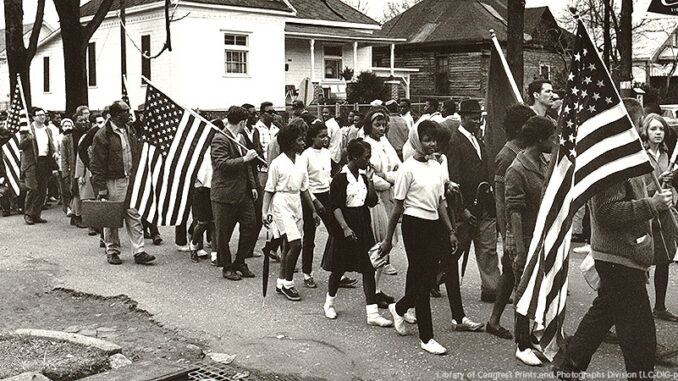
Events of Selma in Graphic Novel
![Marchers carrying banner lead the way as 15,000 parade in Harlem, New York. Photo: Library of Congress Prints and Photographs Division [LC-USZ62-135695]](http://mhebtw.mheducation.com/wp-content/uploads/2015/02/020515_02P_INT-300x221.jpg)
Lewis is considered one of the “Big Six” of the civil rights movement (along with Dr. King, Roy Wilkins, James Farmer, Whitney Young, and A. Phillip Randolph). Lewis was one of the original Freedom Riders (a group of black and whites who rode buses to actively protest the segregation of public buses). As the only living member of the Big Six, Lewis continued to dedicate his life to issues of equality and was elected to the U.S. House of Representatives in 1986, where he has been reelected ever since. He was a special guest speaker at the inauguration of Barack Obama.
What Do You Think? Do you read graphic novels? If so what are some of your favorites? Do you think they should be taken seriously as literature? Why or why not?
Pats Overcome Obstacles to Win Super Bowl
There is always a lot at stake when teams face off at any championship level. But this year, the New England Patriots went into their game against the Seattle Seahawks in Super Bowl XLIX (that’s roman numerals for 49, in case you didnt’ know) shouldered with allegations of wrongdoing. Deflategate (as it was dubbed in the press) alleged that footballs used during the AFC Championship Game against the Indianapolis Colts on January 18, did not contain the proper amount of air. (Underinflated footballs are easier to throw and catch, thereby creating an unfair disadvantage). The NFL is still concluded there was no conspiracy.
The game, held at the University of Phoenix Stadium in Phoenix, Arizona and broadcast on NBC, was seen by a record 49 million people. In the finals minutes of the game, the defending champion Seahawks looked like they were going to score on the Patriots who had pulled ahead 28-24. In one of the most shocking endings in Super Bowl history, Seahawks quarterback Russel Wilson threw a pass that was intercepted in the end zone by Malcolm Butler of the Patriots. The game’s halftime show and the commercials now generate as much attention as the game itself. Pop superstar Katy Perry wowed the audience by riding onto the field on a giant robot-looking tiger and singing her hit song “Roar.” She was later joined by Lenny Kravitz and rapper Missy Elliott.
What Do You Think? Did you watch the big game? If so, which team did you root for? What were your favorite commercials and which ones did you dislike? Explain your answer.
Winds of Change
On the heels of President Obama’s hope for a “re-energized space program” in the State of the Union address, an independent nonprofit called the Planetary Society announced its plan to launch a solar-powered spacecraft called LightSail into orbit. The chief executive of the Planetary Society is William Sanford Nye, whom you may know best as Bill Nye, the Science Guy. Made of BoPET (more commonly known as Mylar), a compact spacecraft will be attached to a U.S. Air Force rocket called Atlas V. Once in space, the sails will unfurl to the size of 344 square feet.
The science behind the mission is to use the sails to harness the energy of the Sun created by bouncing protons off of a shiny surface. That stored energy can then be used to accelerate a spacecraft. In addition to burning less fuel, the solar sails can create a continuous thrust (instead of short bursts created by chemical rockets). NASA originally considered using solar sails in the 1970s. But the size of the sails (nearly 7 million square feet) was considered too risky. Ten years ago, the Planetary Society began raising the funds necessary ($4 million). The launch is scheduled for May.
